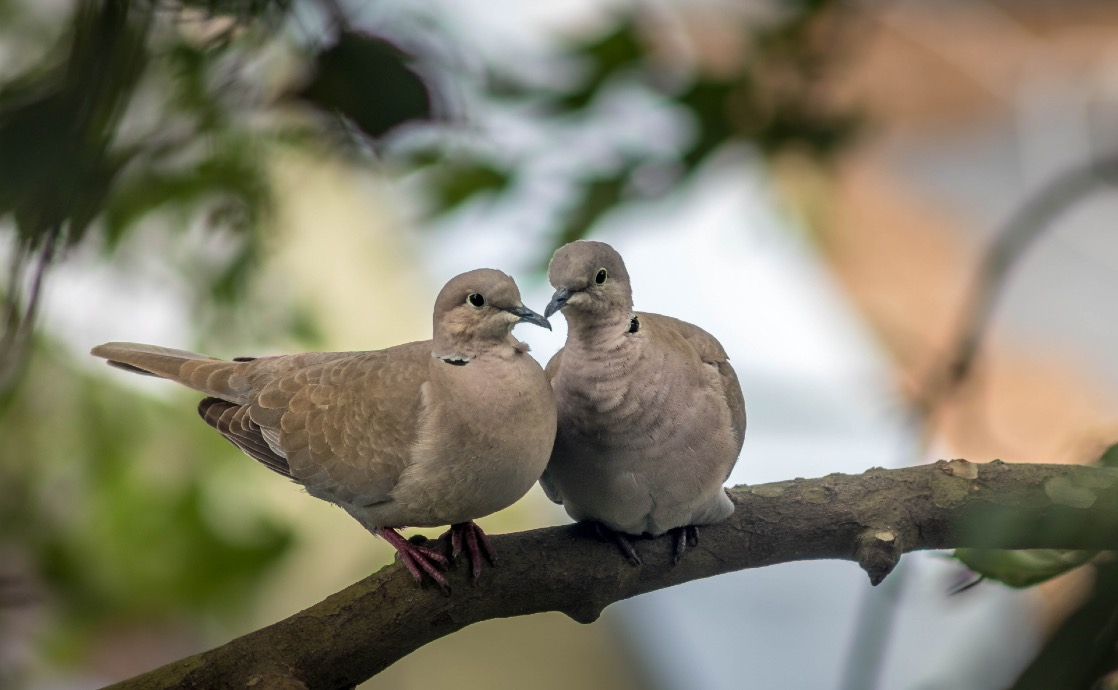The views expressed in our content reflect individual perspectives and do not represent the authoritative views of the Baha'i Faith.
Stout-bodies, short necks, and slender bills are a few characteristics of the bird family, Columbidae — pigeons and doves. In fact, a common pigeon is called both a rock dove and a rock pigeon.
Although there is no scientific difference between pigeons and doves, we generally refer to the smaller birds of this family as doves. While pigeons are often seen as flying rats — especially if you live in a big city — doves seem to have a positive connotation around the world.
RELATED: The Spiritual Meaning and Symbolism of Eagles
That’s likely why doves are referred to as pigeons with good PR agents. Let’s take a look at the symbolism of doves and their spiritual meaning throughout cultures, artworks, and religions.
Doves Meaning Love

Many of you have heard the English Christmas carol, “The Twelve Days of Christmas,” and the verse:
On the second day of Christmas, my true love sent to me
Two turtle doves, and
A partridge in a pear tree.
Like most birds, doves are monogamous and typically mate for life. Both the male and female dove share the responsibility of building the nest, incubating the eggs, and feeding the chicks. They are also very affectionate with their mate and will groom and coo to them. That’s likely why doves have symbolized love, fidelity, and devotion throughout history.
RELATED: The Spiritual Meaning and Symbolism of Sparrows
In Greek mythology, white and turtle doves were considered sacred to Aphrodite, the goddess of love and beauty. In illustrations, a team of doves are depicted drawing her golden chariot through the sky. And, in Aztec mythology, doves symbolize Xochiquetzal, the goddess of love, who they believed is the mother of humanity.

In the Baha’i Faith, doves also spiritually represent how close married couples should become. Abdu’l-Baha, one of central figures of the Baha’i Faith, wrote:
The Lord, peerless is He, hath made woman and man to abide with each other in the closest companionship, and to be even as a single soul. They are two helpmates, two intimate friends, who should be concerned about the welfare of each other.
…Strive, then, to abide, heart and soul, with each other as two doves in the nest, for this is to be blessed in both worlds.
Doves Symbolizing Peace and Harmony

Doves are also spiritually meaningful in the story of Noah’s Ark. In the Bible, after Noah sent a dove to find dry land, it says, “When the dove returned to him in the evening, there in its beak was a freshly plucked olive leaf! Then Noah knew that the water had receded from the earth.”
And, in ancient Greek mythology, the olive tree and branch symbolized peace and friendship. Inspired by the biblical significance of the dove and the Greek symbolism of the olive branch, early Christians began to depict the dove carrying an olive branch in funerary art.

By the 5th century, St. Augustine wrote in his book, “On Christian Doctrine,” that “perpetual peace is indicated by the olive branch which the dove brought with it when it returned to the ark…”
In the Baha’i Faith, doves symbolize peace, harmony, and unity in diversity. In a talk at Howard University in 1912, Abdu’l-Baha said:
The world of humanity, too, is like a garden, and humankind are like the many-colored flowers. Therefore, different colors constitute an adornment. In the same way, there are many colors in the realm of animals. Doves are of many colors; nevertheless, they live in utmost harmony. They never look at color; instead, they look at the species. How often white doves fly with black ones. In the same way, other birds and varicolored animals never look at color; they look at the species.
Now ponder this: Animals, despite the fact that they lack reason and understanding, do not make colors the cause of conflict. Why should man, who has reason, create conflict? This is wholly unworthy of him.
Nowadays, doves are used in political cartoons, banners at anti-war protests, and art and literature to represent pacifism and peace.
Picasso, for example, was against fascism and attended many World Peace Congresses between 1948 and 1951. In 1949, Picasso created “La Colombe” — a composition of a white dove on a black background in a lithographic ink wash. His artwork was used for the poster of the Paris Peace Congress that year and became the symbol of the World Peace Congresses.

At the Peace Congress in 1950 in Sheffield, England, Picasso recalled how his father taught him to paint doves and said, “I stand for life against death; I stand for peace against war.”
At a talk in Paris in 1911, Abdu’l-Baha said, “If only the laws and precepts of the prophets of God had been believed, understood and followed, wars would no longer darken the face of the earth.“
He said, if “people would love and help one another instead of being so eager to destroy with sword and cannon, how much nobler would it be! How much better if they would live like a flock of doves in peace and harmony, instead of being like wolves and tearing each other to pieces.”
















Comments
Sign in or create an account
Continue with Googleor